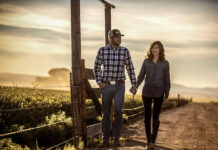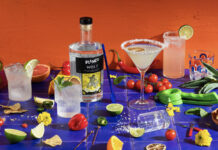In early August of 2010, Anchor Brewing and Distilling, San Francisco’s iconic 104 year-old Brewery was sold. The brewery that Fritz Maytag had brought out of bankruptcy in 1965 and developed into Americas flagship craft brewing and distilling enterprise, was now property of The Griffin Group, a two-man sans-office entity based in Novato, California.
Although an impending sale had been announced in April, the news, inadvertently leaked to the press by a reporter seeking background information on an “embargoed” (pre-announcement heads up) press release, still came as something of a surprise. That Fritz, now in his seventies, would want to step back from the day-to-day stress of operating his brewery-distillery made sense. But who were these guys, Tony Foglio and Keith Greggor, who via the Griffin Group now owned one of the crown jewels of the artisanal world?
One early rumor that circulated with a certain resonance was that the deal was based on real estate — and, truly, the acreage on Potrero Hill, with its designer-chic cachet and unequalled view of the San Francisco skyline, was undeniably worth millions. As someone who had come of age in San Francisco drinking Anchor Steam, and where in the mid-sixties Fritz had opened the doors of the brewery to our band of Vietnam War protestors, troubadours and dreamers, the sale meant a sea change of enormous proportions. Anchor Steam (along with Christmas Ale, Porter, Celebration Ale) was not just a craft beer; it was my craft beer, the one I grew up with. I felt compelled to find out for myself what the new owners were like and what their plans were for my beloved Anchor.
Take Another Little Piece of My Heart…
Arriving early for my interview with Keith Greggor, I took the opportunity to peer deeply into Anchor’s pub room. If you have never visited the tasting room at Anchor Brewing, then just do it, should ever a trip to San Francisco enter your plans. (ADI 2009 Conference attendees will recall the wonderful reception and distillery tour Fritz provided.) The pub room is spacious with large plate glass windows allowing full view of the great copper kettles[1], and it is filled with historical brewing knick-knacks and San Francisco memorabilia. Lots of memorabilia. The beautifully reconstituted illustrated views of “old” San Francisco are magnificent (the Anchor 2010 calendar is a collectors a gem) and one corner of the west wall sports a set of photographs of Big Brother and the Holding Company during a 1966 visit to the brewery, photos that brought a rush of memories. In 1965-66, I shared part of the old Fleishacker Mansion on Oak Street with Jim Gurley (lead guitarist) and Sam Andrew (rhythm & vocals). Gurley particularly enjoyed “cruising the Haight,” feathers in his hair, the whole nine yards, in my 1939 Citroen Onze, plus, on occasion, to various other venues, even — if memory serves — to Anchor Brewing one fine, foggy summer day.
My youthful reverie was gently interrupted by the Anchor receptionist who ushered me in to meet the new owner of Anchor Brewing, now reconfigured as Anchor Brewing and Distilling, LLC.
In person, Keith Greggor is disarmingly casual. At 55, his hair is longish, he sports a moustache-goatee flecked with gray, and looks at you through wire-framed glasses with wide-set bright eyes and an expression of gracious bemusement. He became a US citizen in 2001, but still speaks with a light English accent, and has a slightly self-deprecating manner. Sitting in his office with that stellar view of the skyline behind him, he wasted no time dispelling the “real estate” rumor.
“Oh, yeah,” he said amusedly. “Speculate in real estate during a Recession. That’s me, alright!” He looked through the expansive glass windows and gestured toward the capacious room housing the brewery. “I must say, however, that this has got to be the most expensive brewery per square foot in the world.” He paused, and added: “And, yes, the expense creates a challenge. But the first thing we said to Fritz, once we got around to talking about buying — at first we talked about everything else: philosophy, values, our goals in life, all the things that Fritz cared about and wanted to know before he’d even consider selling to us — was keeping everything under one roof. The last thing on our minds would be to pack it up and go to Fairfield.”[2]
I should mention that I had previously received a note from John Fisher, a Silicon Valley venture capitalist, close associate of Fritz Maytag, and long-time member of ADI giving us a heads up on the “leaked” press release. In his note, John said two very intriguing things: One, that Foglio and Greggor would “bring a new professionalism and distribution scale to craft brewing and to artisan and family/ entrepreneur-owned spirits,” and, Two, that they were going to create an on-site “Center of Excellence” ostensibly to “further contribute to the culture and heritage of craft beer and artisan spirits.” Our interest was further piqued by his descriptor of the Griffin Group as a “boutique merchant investment bank for premiere craft beers and artisan spirits.”
This embrace of craft brewing and micro distilling on three separate fronts — distribution, education, and investment — seemed to proffer some big-time resources for the craft-distilling movement and thus begged for some big-time explication.
Golden Parachutes and Skyy Diving
To say that Tony Foglio and Keith Greggor bring “new professionalism” and “distribution scale” hardly describes the weight behind those terms. Having risen through the turbulent merger-mania era of the 80s and 90’s to the top of their profession — Keith as COO and GMO of Skyy Spirits, and Tony as President and CEO of Skyy. Prior to jointly leading Skyy, Keith served as Group Brand Director for the Paddington Group of International Distributors and Vintners (IDV) managing such giants as Baileys Irish Creme, Malibu Rum, Heublein, Absolut Vodka, Bombay Gin, Grand Marnier, etc., and Tony as CEO of IDV. (IDV is now a major component of drinks giant Diageo). Over the years, they had fashioned a dynamic working relationship that generated huge success for them, for the Paddington Group, for IDV and Grand Metropolitan LLC, their conglomerate owner.
“In those days, it was ‘brands, brands, brands!”’ Keith began, quoting the then CEO George Bull.[3] “We were having a lot of fun. But,” he allowed, “we made the fatal mistake of believing it was our company. We lived and breathed the company, lived and breathed the brands.” And then, as he states it, “I came back from a business trip to find the letter’ on my doorstep.” The Letter that told him he was no longer needed. “The new boss, Chuck Phillips, showed up and flatly refused to talk to any of the senior management. Everything was now going to be run by food guys. We were gone.”
Undeterred, perhaps even slightly relieved, the two turned their attention to Skyy Vodka, a company they had looked at earlier. Skyy was a more-or-less one-man band headed by the San Francisco-based legend Maurice Kanbar, a Vespa-driving inventor who had created what he thought was the perfect vodka — one containing so few congeners that he proclaimed it “hangover-free.” That claim almost cost Skyy its license when an FDA official read an advertisement in an in-flight magazine touting the “health benefits” of hangover-free Skyy Vodka and, according to Keith, “went bonkers.” Tony and Keith quickly ditched the no-hangover idea, initiated the now-famous blue bottle, and, with financial and marketing support from Campari, grew Skyy into one of the top-selling vodka brands in the world.
The Campari angle is worth detailing because it reveals a lot about how Greggor and Foglio view brand development. Campari had been an early investor in Skyy, and was slowly increasing its ownership. However, if Campari were to take control of Skyy, Skyy’s existing distributors would bolt knowing that Campari would replace them with its own channels. The antidote to this potentially brand-killing prospect was to acquire other brands to strengthen the overall portfolio, and they did — with Cutty Sark scotch and Cuervo 1800 tequila. They were building an empire.
“1800 was fun,” Keith confesses. 1800 had been a Cuervo brand, under the distribution thumb of Diageo, but holding steady at about 200,000 cases per year. Diageo was doing quite well with it, but the Beckman family (Cuervo’s original owners) was not. Tony and Keith outlined a strategy to the Beckmans on how Skyy could more than double the sales of the brand to 500,000 cases.
The plan was first to remove Cuervo from the label, whereupon Skyy Spirits could then buy it from Diageo. Since all the Cuervo tequilas were bulk shipped to the U.S. and bottled there as a mixto,[4] step two, as Keith explained was to bottle it in Mexico “using 100% blue agave, and to produce all three styles — silver, reposado, and anejo.” Step three was establishing the price point. “We then priced it above where it had been with Cuervo,” Keith explained, “but below the premium level.” The Beckmans agreed, and the strategy was a huge success. Subsequently, in 2001, Campari completed the acquisition of the empire of Skyy, and once again Tony and Keith were gone, but this time with golden severance packages and a combined resume that was a litany of brand achievements second to none.
At that point, the two were living in the Bay Area, Tony in the City proper, Keith up the road in Novato. “It was a dream come true to arrive here,” Keith explained. “I had grown up in Singapore, and then worked in Scotland, and Ireland, but always I wanted to live in San Francisco. To me it was just the most creative, fun place in the world to be. It still is.” Ensconced in the beautiful environs of the Bay Area, the two figured they were retired. “But we’re just not retired-type guys,” Keith allowed. “So we started looking around.”
Their first step was to form the Griffin Group, the self-proclaimed “boutique merchant investment bank for premiere craft beers and artisan spirits.” Their initial investment was in Brewdog,[5] a small brewery north of Aberdeen, Scotland, run by two young guys in their early twenties, “making the most fabulous beers I have ever tasted,” says Keith. “They were so smart, so informed — they just blew me away.” Their next investment was the acquisition of Priess Imports from distributor legend Henry Priess, whose San Diego-based emporium carries an almost overwhelming array of premium spirits and liqueurs. The Priess Imports catalog, as hefty and sleek as a copy of Vanity Fair, presents a cornucopia of extraordinary spirits including single malts from Duncan Taylor, Springbank, BenRiach, GlenDronach, Longrow, Kilkerran, stellar liqueurs from Luxardo (Marschino, Limoncello, Amaretto) not to mention pisco, absinthe, tequila and a list of rums that ache to be tasted (D’Arisiti Yucatan, Toucano, English Harbour). And now newcomers Coopers Ale from Australia and the illuminating innovations from Brewdog.
The Henry Priess acquisition seemed to be a perfect fit with the burgeoning philosophy of Griffin with its focus on “lifestyle” (read premium) brands with great authenticity, and heritage. “We acquired Priess in 2008,” Greggor noted with what I was beginning to realize was a signature edge of wry wit, “and had one profitable month before the Recession hit.”
Recession or no, Greggor remains firm in his commitment to the premium niche. His strategy? Education. “Knowledge,” Greggor opines, “is the hardest thing for the large corporations to
accumulate. And yet,” he adds, “It’s their greatest asset.” The underlying marketing principle in Greggor’s mind is simply this: The more educated and knowledgeable people are, the greater the case can be made for asking a premium price. He points specifically to Luxardo Maraschino Liqueur. “Once people understand the craft and care behind it, when they can see the cherry trees behind the distillery, and understand that it takes three years of maturation before it can be released — then they understand and appreciate its expense.”
The model he invokes for knowledge and communication is Berry Bros. & Rudd, Britain’s oldest wine and spirit merchant, and still trading from the same shop it has occupied for over 300 years.[6] He calls the imported version a “Center of Excellence,” and envisions it as a powerful force for education in all things craft.
“The Center of Excellence”
The Center will be housed in a large relatively unused office/ warehouse on Anchor’s Potrero Hill property, and Keith can point out its various merits from his office window. Part tasting barn, part brewing and distilling workshop, part outreach, Greggor envisions mixology classes targeted to higher-end bartenders, focused workshops on spirits-paired cuisines, and perhaps general events, open to the public, where people can meet face-to-face with the artisans behind the products.
In print, the Center is described as an “epicenter of development, education, entertainment and innovation, all designed to further contribute to the culture and heritage of craft beer and artisan spirits.” Setting aside the relative merits of directly linking the word “epicenter” to the city of San Francisco, in real terms what Greggor is imagining is a world-class academy of hooch. So, what about Anchor Brewing and Distilling hosting ADI’s 2013 Annual Conference here?
“We may be ready by then!” Greggor notes with a grin. “We’re just getting started. But it does sound like something we’d want to do.”
And the prospect of the Griffin Group offering financial or distribution assistance to other craft distillers? “I’m in the ‘listen-and- learn’ phase right now,” he replies. “But that is what we do.”
And the shift in focus from building brands to operating a brewery-distillery? “It’s profound,” Greggor notes. “We are now involved much more with process. It’s an immense transition for us, and a truly exciting one.”
On the way out, I pause again to regard the photos of the band in the tasting room. There they are, Janis, Jim, Sam, the whole group, just as they were, and just as I remember them. But that fabled era is long behind us, and certainly for Anchor, with its 40 some years of deep-set San Francisco roots, a new one has begun.
[1] A 360° view of this fascinating view is available on the Anchor website: http://www.anchorbrewing.com/brewery/liveview.htm
[2] Fairfield is a suburb of San Francisco where real estate is inexpensive (relative to San Francisco), and where A-B has huge facility.
[3] Sir George Bull was head of Grand Metropolitan, LLC, owner of, among many famous brands, Burger King, Pillsbury, Heublein, and Smirnoff Vodka. In 1997 Guinness merged with Grand Metropolitan and United Distillers merged with International Distillers & Vintners to create United Distillers & Vintners. The business is now part of Diageo.
[4] A mixto (miss-toe) is tequila that is 51% blue agave and 49% GNS diluted to 8o proof with distilled water.
[5] Brewdog’s “Sink the Bismarck” which at 41% beat out its first “super beer” Tactical Nuclear Penguin that weighed in at 32% abv. Schorschbrau in Germany has since responded with a 43% version of Schorschbock to regain the abv title.
[6] www.bbr.com. Officially established in 1698 by the Widow Bourne at 3 St James’s Street in London, opposite St James’s Palace, Berry Bros. & Rudd evolved from selling provisions, exotic spices, tea and coffee to, ultimately, fine wines and scotch whisky. Berrys first supplied wine to the British Royal family during the reign of King George III and has continued to do so to the present day.














